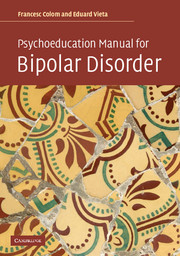Book contents
- Frontmatter
- Contents
- Foreword
- Preface
- Part 1 Clinical, diagnostic, and therapeutic aspects of bipolar disorders
- Part 2 Concept and methodology of psychoeducation
- Part 3 Psychoeducation program: sessions and contents
- Unit 1 Awareness of the disorder
- Session 1 Presentation and rules of the group
- Session 2 What is bipolar disorder?
- Session 3 Etiological and triggering factors
- Session 4 Symptoms I:Mania and hypomania
- Session 5 Symptoms II: Depression and mixed episodes
- Session 6 Evolution and prognosis
- Unit 2 Drug adherence
- Session 7 Treatment I: Mood stabilizers
- Session 8 Treatment II: Antimanic drugs
- Session 9 Treatment III: Antidepressants
- Session 10 Plasma levels of mood stabilizers
- Session 11 Pregnancy and genetic counseling
- Session 12 Psycho-pharmacology vs. alternative therapies
- Session 13 Risks associated with treatment withdrawal
- Unit 3 Avoiding substance abuse
- Session 14 Psychoactive substances: risks in bipolar disorders
- Unit 4 Early detection of new episodes
- Session 15 Early detection of mania and hypomanic episodes
- Session 16 Early detection of depressive and mixed episodes
- Session 17 What to do when a new phase is detected?
- Unit 5 Regular habits and stress management
- Session 18 Regularity of habits
- Session 19 Stress-control techniques
- Session 20 Problem-solving strategies
- Session 21 Closure
- Final note: Is psychoeducation efficacious?
- Bibliography
- Index
Session 14 - Psychoactive substances: risks in bipolar disorders
from Part 3 - Psychoeducation program: sessions and contents
Published online by Cambridge University Press: 06 January 2010
- Frontmatter
- Contents
- Foreword
- Preface
- Part 1 Clinical, diagnostic, and therapeutic aspects of bipolar disorders
- Part 2 Concept and methodology of psychoeducation
- Part 3 Psychoeducation program: sessions and contents
- Unit 1 Awareness of the disorder
- Session 1 Presentation and rules of the group
- Session 2 What is bipolar disorder?
- Session 3 Etiological and triggering factors
- Session 4 Symptoms I:Mania and hypomania
- Session 5 Symptoms II: Depression and mixed episodes
- Session 6 Evolution and prognosis
- Unit 2 Drug adherence
- Session 7 Treatment I: Mood stabilizers
- Session 8 Treatment II: Antimanic drugs
- Session 9 Treatment III: Antidepressants
- Session 10 Plasma levels of mood stabilizers
- Session 11 Pregnancy and genetic counseling
- Session 12 Psycho-pharmacology vs. alternative therapies
- Session 13 Risks associated with treatment withdrawal
- Unit 3 Avoiding substance abuse
- Session 14 Psychoactive substances: risks in bipolar disorders
- Unit 4 Early detection of new episodes
- Session 15 Early detection of mania and hypomanic episodes
- Session 16 Early detection of depressive and mixed episodes
- Session 17 What to do when a new phase is detected?
- Unit 5 Regular habits and stress management
- Session 18 Regularity of habits
- Session 19 Stress-control techniques
- Session 20 Problem-solving strategies
- Session 21 Closure
- Final note: Is psychoeducation efficacious?
- Bibliography
- Index
Summary
Goal
Substance abuse or dependency problems are very frequent in the bipolar population, involving about 50% of patients according to some studies. Seven out of ten bipolar men abuse alcohol during mania, thus complicating its course. The goal of this session above all is for our patients to become aware of the risk, not of hard drugs (if indeed the distinction between hard and soft drugs makes any sense), but of more everyday-drugs like coffee and alcohol. This awareness is crucial because the number of bipolar patients who use caffeine is very high and the majority of them do not even view this behavior as a problem, although its effect on sleep and on comorbid pathologies that are very common in bipolar disorders such as panic attacks is very obvious.
Procedure
While the therapist talks informally to the group members, one of the co-therapists can write the following list on the blackboard:
– Beer.
– Wine.
– Joints (marijuana).
– Whisky, rum, and other hard liquors.
– Acid (“trips”).
– Cocaine.
– Amphetamines.
– Stimulating beverages (Red Bull).
– Cola drinks.
– Coffee.
– Ecstasy and other designer drugs.
Once our informal chat is over, we put the following question openly to the whole group: “Which of the substances listed on the blackboard do you think are potential dangers for a person suffering from bipolar disorder?” Most of the patients will exclude some of the substances from the list, generally coffee and cola drinks but also sometimes wine and beer, and even marijuana.
- Type
- Chapter
- Information
- Psychoeducation Manual for Bipolar Disorder , pp. 149 - 155Publisher: Cambridge University PressPrint publication year: 2006

